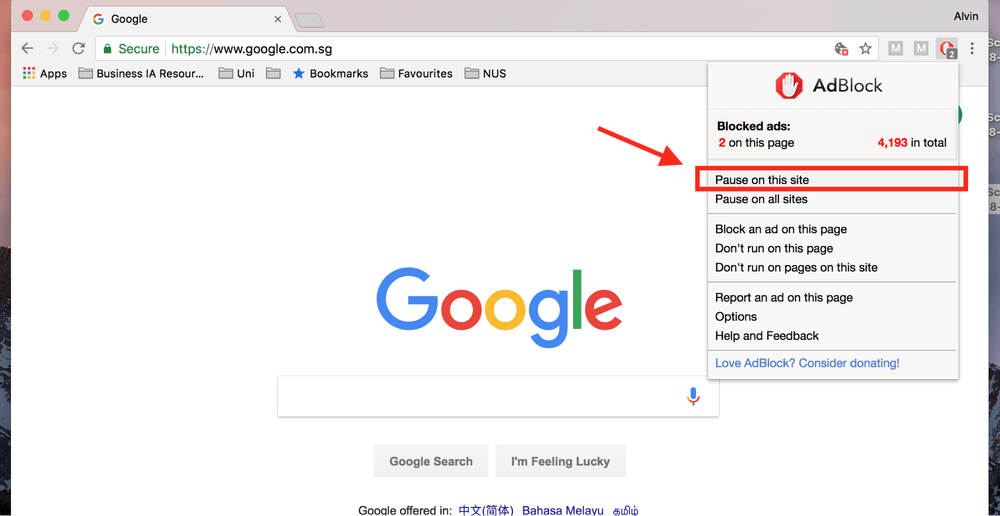Chrome Adblock For Mac
It’s been a while that I’ve moved from Safari to Chrome on iOS. Google’s browser is pretty good performance-wise, syncs my personal information seamlessly, and features an interface that’s both fun and easy to use. But Chrome's complete inability to block ads does get on my nerves all the time. Too often, I’ve had to fall back to Safari for those ad-ridden sites that won’t allow a normal experience without an ad blocker.

Just the other day, I had enough of switching browsers. I browsed the App Store for Chrome-supported ad blockers. Of course, there aren’t any (who am I kidding?). But I didn’t give up. Crawled through various forums looking for workarounds, and to my surprise — I found a way! What you are going to learn isn’t the most convenient of ways to block ads, but let me share it with you so that you can decide for yourself.
AdGuard DNS to the Rescue

My workaround involves using the domain name system (DNS) servers of a popular ad blocking service called AdGuard. It requires nothing overly technical — set up the AdGuard DNS with your internet connection, and you end up filtering IP addresses and trackers related to major ad serving platforms. Pretty cool, huh? And if you were wondering, AdGuard is very open to you using their DNS servers, so it’s not as if you are doing anything wrong.
Macx video converter pro is the fastest video converter for mac users to convert any video to mp4 h. 264 mov flv avi etc for playing on ios android tabs and phones with superb quality, macx video converter pro is the best and fastest video converter for mac user that can convert video to any format like mp4 h / download and convert youtube videos to different video formats for offline. Get more done with the new Google Chrome. A more simple, secure, and faster web browser than ever, with Google’s smarts built-in. Block ads in Chrome on the Mac. Google's Chrome browser is a popular alternative for Mac users, and even though Google is a full paid-up member of the advertising fan club, it allows plenty of. Alternatives to Facebook AdBlock for Chrome for Mac, iPhone, iPad, Chrome, Windows and more. Filter by license to discover only free or Open Source alternatives. This list contains a total of 25+ apps similar to Facebook AdBlock for Chrome. List updated: 3/5/2020 10:55:00 AM. AdBlock is not available for Mac but there are plenty of alternatives that runs on macOS with similar functionality. The most popular Mac alternative is uMatrix, which is both free and Open Source.If that doesn't suit you, our users have ranked more than 50 alternatives to AdBlock and many of them are available for Mac so hopefully you can find a suitable replacement.
Just apply the AdGuard DNS to your internet connection, and you end up filtering IP addresses and trackers related to major ad serving platforms
But there’s a catch. Setting up AdGuard DNS servers on your iPhone or iPad blocks ads not just on Chrome, but on every other app as well — consider it as something akin to a system-wide adblocker. So, don’t be surprised to find out certain apps — such as free-to-play games — failing to work properly due to their inability to serve ads, in which case you have to consider resetting the DNS servers.
There’s another problem — iOS only lets you configure DNS servers for Wi-Fi connections. And even then, you need to do that manually for every Wi-Fi connection that you join — although not repeatedly when rejoining the same hotspot. So then, what about blocking ads while surfing on cellular data?
iOS only lets you configure DNS servers for Wi-Fi connections
To circumvent the limitation, I tried using a paid app that claimed to override default DNS settings for cellular data. Looked around even more for an alternative, and stumbled upon an app called DNSCloak that supposedly secures you from DNS spoofing. And to my pleasant surprise, it features a built-in AdGuard DNS server profile that you can use to get rid of ads on both Wi-Fi and cellular completely.
Regardless, I'm not going to forego changing Wi-Fi DNS servers manually. It's risk-free compared to DNSCloak, which may have unknown security concerns that I'll mention while we move along.
Also on Guiding Tech

How to Disable Suggested Articles in Chrome for iOS and Android Without Affecting Search
Read MoreBlocking Ads on Wi-Fi
iOS lets you modify the DNS servers for any Wi-Fi connection quite easily. But as I mentioned earlier, you need to apply it whenever you connect to a new Wi-Fi hotspot — once you’ve configured the DNS servers, the device uses those settings whenever you rejoin the same hotspot.
In my case, I've set up the AdGuard DNS servers for my home Wi-Fi connection, as well as on public networks that I frequent to. And for those other random networks, I either deal with the ads or use DNSCloak if I find them too annoying.
The following steps should walk you through the process required to block ads on a Wi-Fi connection.
Step 1: On the iOS Settings app, tap Wi-Fi. Next, tap the i-shaped symbol next to the connected Wi-Fi network.
Step 2: Tap the option labeled Configure DNS.
Step 3: Tap Manual, and then remove the current DNS servers for your Wi-Fi connection.
Note: Consider noting down or a taking a screenshot of the existing DNS servers just in case you need them for later. However, you can also choose to forget the connection and reconnect to it to revert to the default DNS servers automatically.Step 4: Insert the following AdGuard DNS servers into two separate slots, and then tap Save.
176.103.130.130
176.103.130.131
That’s it. Now it's time to head over to Chrome, load up any site, and enjoy an ad-free experience. I faced no issues while using the AdGuard DNS servers — they blocked nearly every ad that I came across, except for a few sites where I did encounter a few pop-up tabs. But for the most part, it felt refreshing to finally find ads gone from what’s now my favorite browser on iOS.
Also on Guiding Tech
How to Easily Download Any PDF on Chrome for iOS
Read MoreBlocking Ads with DNSCloak

I was quite lucky to stumble across DNSCloak. It's a completely free app that offers the ability to thwart DNS spoofing. In simpler terms, DNSCloak verifies that there is no tampering with the responses to and from servers that you connect to. The app accomplishes that by using a virtual private network (VPN) profile, which does raise a few hairs.
VPNs, the free ones in particular, may carry certain privacy-related risks. But from the looks of it, I found that the app uses a dummy VPN which loops back connection requests to your iPhone or iPad and resolves them locally. Hence, you shouldn't be too worried in terms of security. However, I recommend that you refrain from using DNSCloak when dealing with sensitive data as a precautionary measure.
DNSCloak uses a dummy VPN which loops back connection requests to your iPhone or iPad and resolves them locally
Regardless, what makes DNSCloak quite special is its inclusion of a pre-built AdGuard DNS profile that enables system-wide adblocking. And thanks to the fact that it funnels all connection requests through the dummy VPN profile. The app not only blocks ads on Wi-Fi connections but also on cellular data. That's great news for Chrome users.
The following steps should walk you through blocking ads with the AdGuard DNS servers using DNSCloak.
Step 1: Download and install DNSCloak from the App Store.
 Download DNSCloak
Download DNSCloakStep 2: Launch DNSCloak. You should see a list of DNS filters listed on the main screen of the app. Tap on the one labeled adguard-dns and then tap Use This Server.
Step 3: On the pop-up menu, tap Allow.
Step 4: Use Touch ID or Face ID to authenticate the new VPN configuration.
You can now surf on Chrome without encountering any advertisements on both cellular data and Wi-Fi. Do remember that the same applies to other apps as well.
Note: To deactivate the AdGuard DNS filter, tap Stop Using This Server under adguard-dns.If you want to know that you're actively using DNSCloack while surfing, turn on the Show VPN Icon from the DNSCloak Settings panel. That will make the VPN icon appear on the status bar of your iPhone or iPad. Neat stuff!
While you can use DNSCloak to block ads pretty easily, consider using the manual workaround discussed above for instances where your privacy is of the utmost importance. At the end of the day, you can’t really trust a free app too much regardless of what it claims to be. But when it comes to cellular data, it's DNSCloak or nothing.
Also on Guiding Tech
Chrome Adblock For Android
#How-to/Guides
Click here to see our How-to/Guides articles pageFreedom from Ads
An ad-free experience on Chrome for iOS finally feels damn liberating. Don’t get me wrong — I’m not against all advertisements. They provide a vital source of revenue for online content creators. My problem is with those annoying pop-up ads that websites shove in your face and you really have no choice. That ruins the browsing experience.
Thankfully, now we have a couple of alternatives like AdGuard DNS and DNSCloak to the rescue. So, what do you think of these workarounds? Any suggestions? The comments section is right below. In the meantime, check out this video that shows how to block ads on iPhone for free.
Adblock Chrome Mac Free Download
The above article may contain affiliate links which help support Guiding Tech. However, it does not affect our editorial integrity. The content remains unbiased and authentic.Read NextShould You Use a Sync Passphrase on Chrome?Also See#chrome #adblockDid You Know
The iPhone XS Max run graphics 50 percent faster than the older iPhone X.
More in iOS
20 Best iPhone Apps With Useful Widgets
